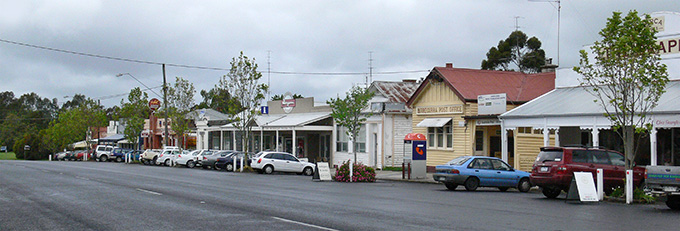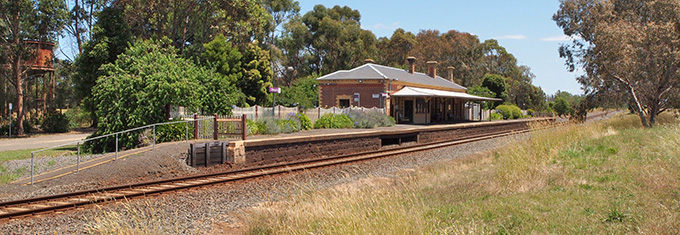Birregurra

Birregurra is a small, thriving town of about 600 people, approximately 18 km east of Colac. To get there from Colac follow the Princes Highway (A1) east until Warncoort, turning right onto the C152.
The name Birregurra is derived from the aboriginal word 'burai gurray' or kangaroo camp, their name for springs near Chas. Beal's Bleak House mansion.
Buntingdale Mission
Although there was some activity by squatters from the mid 1830s, the first real white settlement in the Birregurra area was the establishment in 1839 of the Buntingdale Mission Station, some four miles upstream on the Barwon River from the site of the present township. The Mission was operated by the Wesleyan Missionary Society, a London-based organisation promoting Christian knowledge in foreign parts. It was named after the English preacher, Reverend Jabez Bunting. It was visited in 1841 by Protector of Aborigines, George Robinson, who amused the inhabitants with a fireworks display.
The Mission was run by the
Reverend Francis Tuckfield and its location was carefully chosen to be at
the junction of three or four tribal territories. It soon became clear however
that the Coladjins were resentful because the missionaries were welcoming
their enemies and the journeys the aboriginals were compelled to make to
reach the Mission brought smaller tribes into contact with more aggressive
rivals. Feuds flared continually, lives were lost and the aboriginals eventually
resumed their nomadic existence. Numbers continued to fall as many succumbed
to white man’s diseases and some to poisoned sheep and flour.
Despite Tuckfield’s enlightened devotion the Mission made little progress.
Land was let and stock numbers built up with the help of local settlers.
Captain Bowden was among those employed as overseers and the present town
site became known as Bowden’s Point in 1850s before it became known as Birregurra.
In 1848 the stock was sold, Reverend Tuckfield left for Geelong and the land was subdivided and sold in 1851. In that same year the Mission buildings were destroyed in the ‘Black Thursday’ bush fires. The only reminders of the Mission today are its bell, which is held inside Christ Church, Birregurra, and a memorial cairn in the grounds of the McLennan Memorial Uniting Church. The site of the Mission is on private land and is not accessible to the public.
Early days of Mt Gellibrand and Birregurra
A squatting run established by Charles Ayrey in 1841 was named after the explorer J.T. Gellibrand who disappeared in the area in 1837. This point became the location of the Traveller's Rest Hotel and the first settlement in the area outside the Buntingdale Mission, a convenient stop for travellers between Colac and Geelong.
The opening of the Cape Otway Road in 1861 and the construction of bridges across the Birregurra Creek and Barwon River made the present site of Birregurra a convenient location for a township, and the move became formal in 1864 with the opening of the Birregurra Post Office, the original town becoming officially Mount Gellibrand. For a while the town was known as Birregurra on the Barwon
Farming began in earnest on the fertile Barwon River flats with crops of wheat, potatoes, barley, turnips, onions and swedes and Birregurra became a market town for fattened cattle driven from the Otways. The settlement also boomed with the emergence of the timber industry harvesting the rich resource of the Otways forests.
'Tarndwarncoort' was built in the 1850s by Alexander Dennis at Warncoort. The property is still owned by descendants of Alexander Dennis who still run Polwarths, the first Australian breed of sheep the family bred and introduced in the 1880s. Tarndwarncoort is the local aboriginal name used to describe a bandicoot running. The name Warncoort, applied to the locality is an abbreviation of the same word.
The Royal Mail Hotel in Main Street was first licensed in 1871 and is the only remaining of several hotels in the town. In 1874, when the town's population was 392, the first official post office was opened and the telegraph was connected. The first telephones were connected in 1909.
The Native Youth Hotel, also in Main Street, was built in the 1860s as a Cobb & Co. coaching station. It was unlicenced in 1921, was eventually divided into flats and is now being restored. In the sidestreet adjacent to the hotel building is one of the horse troughs built as part of the estate of George Bills which funded the provision of 500 horse troughs around Australia as well as some overseas.

Birregurra, like Colac, is on the main broad gauge railway line to the south west coast, terminating presently at Warrnambool, with three trains daily to and from Melbourne. The Birregurra to Forrest rail link, opened in 1891 and closed in the late 1950s, was used by many people heading to the coastal resort town of Lorne. Only the main line now remains and the original station building and water tank are the only structures remaining.
More information on Birregurra and its history can be obtained from the Birregurra Historical Centre in Main Street, which is open on Sundays between 2 and 4pm, other times by appointment.
Churches in Birregurra

Birregurra is certainly a town of churches. On the left is St Peter's Roman Catholic Church, built in 1907 to replace an earlier timber structure. On the right is the superb bluestone Anglican Christ Church, opened in 1871. The bell tower and spire were added in 1890. The church houses the Buntingdale Mission brass bell (see story above) and a cork oak, at least 120 years old, stands in the church grounds.
Weekend Festival and Markets
The Birregurra Weekend Festival (above) is held each year in October and is a celebration of local arts, craft, produce and music. Sunday Market in the Park is held on the second Sunday of each month from December to April, 10am–2pm, showcasing quality craft and local produce. Remember to bring shopping bags as Birregurra is Victoria's first plastic shopping bag free town.
Birregurra & District website.
